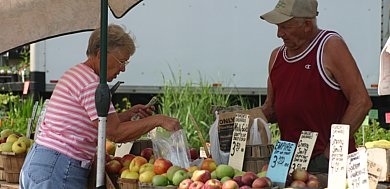WOOSTER, Ohio — “Food deserts” are normally thought of as low-income, blighted urban neighborhoods with little access to fresh, reasonably priced fruits and vegetables. But rural areas, despite their wide-open spaces and fertile farmland, can be food deserts, too.
An Ohio State University Extension community development specialist worked with two student interns to examine this seeming paradox to discover more about people who live in rural food deserts and how they access fresh produce.
According to the U.S. Department of Agriculture, rural residents who live at least 10 miles away from a grocery store live in a food desert, said Tom Blaine.
“Participants in our study lived an average of 11 miles from a grocery store,” Blaine said. “Typically in more populated areas, you have a grocery store within a half-mile or mile.
“For most people in Ohio, 11 miles from a grocery store would be a very long way.”
Money
The 22-mile round trip equates to an average transportation expense of $735 a year, he said. The study involved phone interviews with 90 residents along the border of Wayne and Holmes counties to determine how they acquire, produce and consume fresh fruits and vegetables and to gather demographic information.
For the study, Blaine led a brother-and-sister team, Sarah and Michael Pinkham, who were involved in the Ohio Agricultural Research and Development Center’s Ohio Research Internship Program (ORIP) during summer 2012.
The idea for the study originated with OARDC’s Parwinder Grewal, a professor of entomology who directs the summer ORIP program.
“The lack of opportunity to buy fresh fruits and vegetables in rural areas can be an important barrier to a healthy diet, just as it is in the city,” Blaine said. “Many of us might assume that there is a lot of produce out there, but that’s not necessarily true.
“Most agricultural production is not fresh produce, it’s grain and livestock. So we wanted to study these folks who live in rural areas more closely to see how they operate, and what steps they take in gaining fresh fruit and vegetables.”
Findings
Among the study’s findings:
Most respondents, 74 percent, had a garden that allowed them to grow their own fresh produce. In all, 28 percent of the households grew at least one-third of their produce, and 43 percent grew at least one-quarter of the produce they consumed.
The elderly were the least likely to have a garden and grow their own produce.
“Many said they had gardened all their lives, but now their health doesn’t permit it,” Blaine said. “They just don’t have the mobility or endurance to get out and work in the garden.”
Senior citizens also may have more challenges driving to the grocery store, he said, which presents an additional disadvantage to getting access to fresh fruits and vegetables.
High-income households also were less likely to have a garden. Blaine suspects that these residents work longer hours than average, preventing them from having time to garden.
People who eat more produce are more likely to have their own garden.
Households with more people are more likely to have a garden.
“Not only do larger families need more food in the house, but they have additional labor to keep the garden up,” Blaine said. Blaine said he hopes the findings of this study will raise awareness of rural food deserts and encourage more people to do gardening.
“It’s a double-winner for people,” he said. “When you get out and garden, you’re exercising, you’re moving. It’s a lot healthier than sitting around the house.
“And you’re producing something that’s healthy to eat. If you can substitute a freshly grown green pepper or tomato for potato chips or doughnuts, you’ll be better off.”












See http://www.fooddeserts for UK’s food deserts